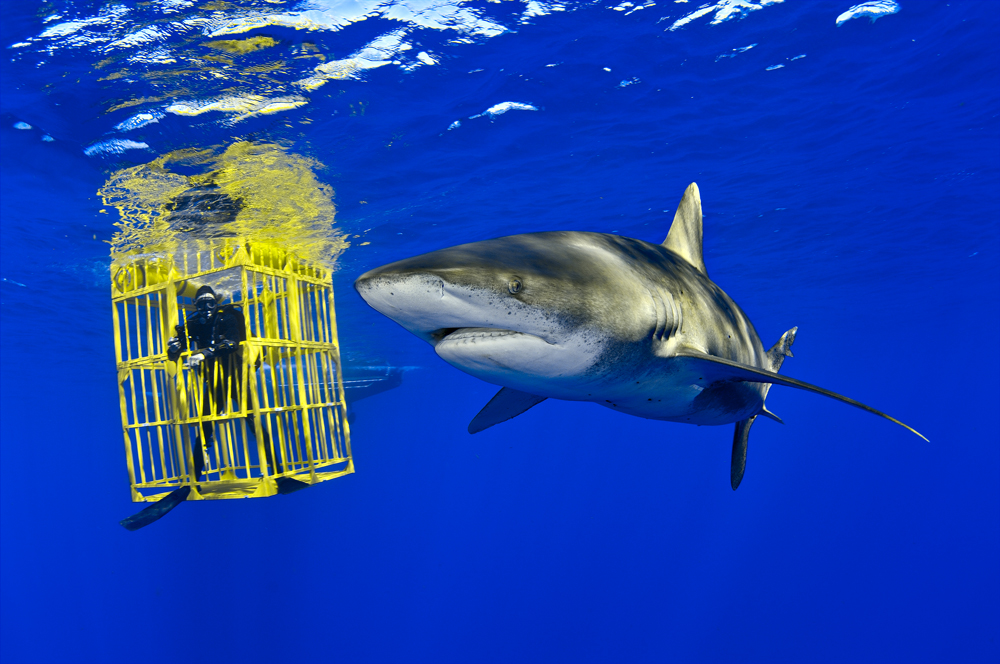International Shark Conservation
 A Great Hammerhead, (Sphyrna mokarran), swims near the surface in The Bahamas near sunset. Photo Credit: Brian Skerry
A Great Hammerhead, (Sphyrna mokarran), swims near the surface in The Bahamas near sunset. Photo Credit: Brian Skerry
 Basking sharks are social animals and form sex-segregated schools, usually in small numbers (3 or 4) but reportedly up to 100 individuals.
Basking sharks are social animals and form sex-segregated schools, usually in small numbers (3 or 4) but reportedly up to 100 individuals.
 Oceanic Whitetip Shark swims past biologist Wes Pratt inside the shark cage. Bahamas. Photo Credit: Brian Skerry
Oceanic Whitetip Shark swims past biologist Wes Pratt inside the shark cage. Bahamas. Photo Credit: Brian Skerry
Useful Links |
As one of the top predators of the oceans, sharks play an important role in the food web and help ensure balance in the ocean’s ecosystem. As demand and exploitation rates for some shark species and shark products (i.e., fins) have increased, concern has steadily grown regarding the status of many shark stocks and the sustainability of their exploitation in global fisheries. Relative to other marine fish, sharks are characterized by relatively slow growth, late sexual maturity, and a small number of young per brood. These biological factors leave many species of sharks vulnerable to overfishing. Sharks are captured in directed fisheries and also as bycatch in other non-directed fisheries. Many shark species have been over-exploited because their fins are highly valued for shark fin soup. Globally there is a general lack of data reporting on the catch of sharks, particularly species-specific data. For these reasons, sharks present an array of issues and challenges for fisheries conservation and management.
NOAA's Role in Shark Conservation
Despite these challenges, NOAA is committed to achieving sustainable management of sharks. NOAA Fisheries manages the commercial and recreational shark fisheries in the Atlantic Ocean and works with three regional fishery management councils to conserve and sustainably manage sharks in the Pacific Ocean. By conducting research, assessing stocks, working with U.S. fishermen, and implementing restrictions on shark harvests, NOAA Fisheries has made significant progress towards ending overfishing and rebuilding overfished stocks for long-term sustainability. No shark species are currently listed under the Endangered Species Act and, for those shark species whose stocks are overfished, NOAA Fisheries puts management measures in place to rebuild the stock to a sustainable level. The United States also supports and implements the landing of sharks with their fins naturally attached. This policy enables the collection of species-specific information needed for shark management and conservation, and enhances the ability to enforce existing shark regulations domestically.
Setting the Stage Internationally
The United States continues to be a leader in promoting the conservation and management of sharks globally. We work internationally within regional fisheries management organizations and other international bodies to promote the adoption of conservation and management measures for sharks. NOAA was instrumental in getting shark conservation and management measures approved at these international bodies, and we are working internationally to promote our fins naturally attached policy overseas. We provide technical assistance to other countries in support of their shark conservation efforts. These activities include training in shark identification and data collection workshops. We also collaborate with other countries on research aimed at achieving science-based management measures and conservation of sharks in our global ocean.
For questions about international shark conservation, please contact
Cheri McCarty (cheri.mccarty@noaa.gov).
SHARK FACTS—Did you know?
|



